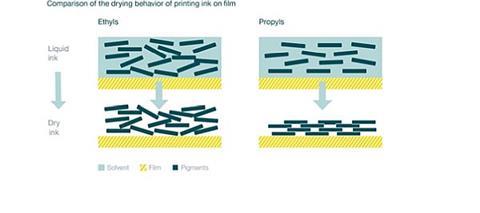
Propyls from Oxea, n‑propanol, n-propyl acetate or mixtures thereof, are a direct 1:1 substitute for conventional ethanol and ethyl acetate blends (Ethyls).
The economic advantages of Propyls in flexography and rotogravure printing can be described as follows: Consumption savings of 20 per cent in ink on average and 30 per cent in solvents on average without any changes to the printing infrastructure, and on the technical side, better printing quality, more efficient printing runs, higher printing speeds, and a more stable and sustainable printing process overall can be achieved.
“Very often, printers are not aware that they can optimize and troubleshoot their printing processes with little effort when they leave the solvent out of the equation. For want of alternatives, in the past, their use of traditional solvents was rarely questioned, when in fact Propyls can remedy many problems and contribute to higher process stability. We found that the direct substitution of Ethyls with Propyls is very simple and technically straightforward,” says Dr. Jens Klabunde, Technical Business Development Manager at Oxea.
Technically, Propyls reduce the so-called plugging (drying out or clogging) of the cells on the printing cylinder or aniloxes. As a medium evaporating solvent, Propyls evaporate more slowly than Ethyls but ensure that the ink dries reliably in the process. Therefore, with Propyls, fewer refills of solvents are required to maintain the target viscosity during the printing process, which leads to a significant reduction of solvent consumption and generally lower emissions of harmful substances, so-called VOCs (volatile organic compounds). In a Propyls solvent system, the pigments of the printing ink can distribute more homogeneously on the film during application due to the slightly slower drying process. This results in a higher ink density for the same amount of pigment. In this way, the printer achieves the same print quality with significantly less pigment, which saves expensive base ink.
Also, improved emptying and pick-up characteristics of both the engraving cylinder and the anilox ensure optimum transfer of the printing ink onto the substrate. Thanks to the slower evaporation rate of Propyls, it is possible to increase the speed of the printing presses in many cases without compromising print quality. Finally, Propyls demonstrate less foam formation tendency than Ethyls in flexography printing, especially when it comes to warm and humid ambient weather conditions. These findings have been validated in a study that was carried out at the Hochschule der Medien (HdM), Stuttgart, Germany, in 2018. They concluded that Propyls surpass conventional solvents such as ethyl acetate and ethanol in gravure or flexography processes without the need for further adjustment.

This content was sponsored by Oxea.









